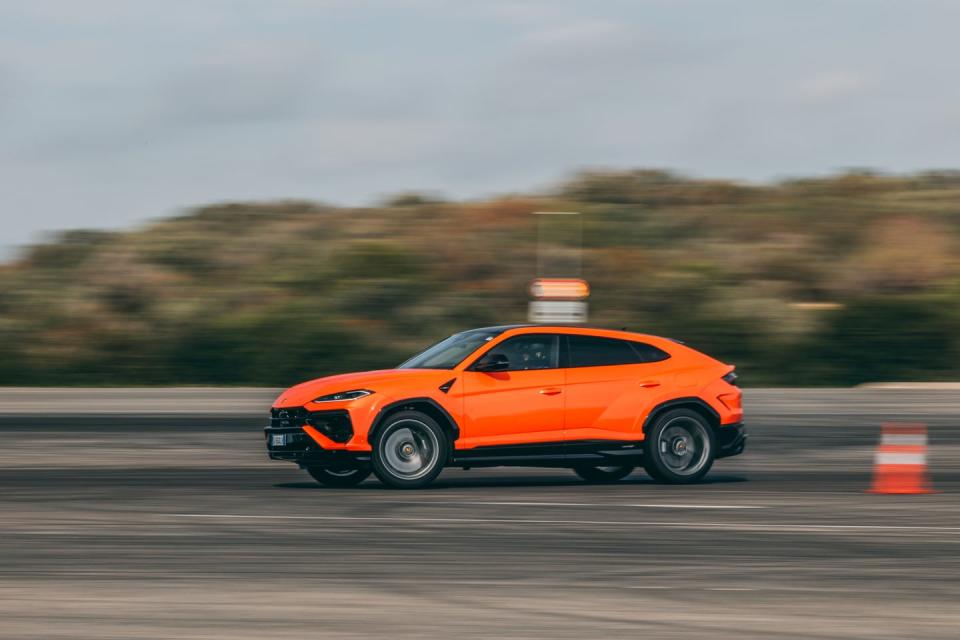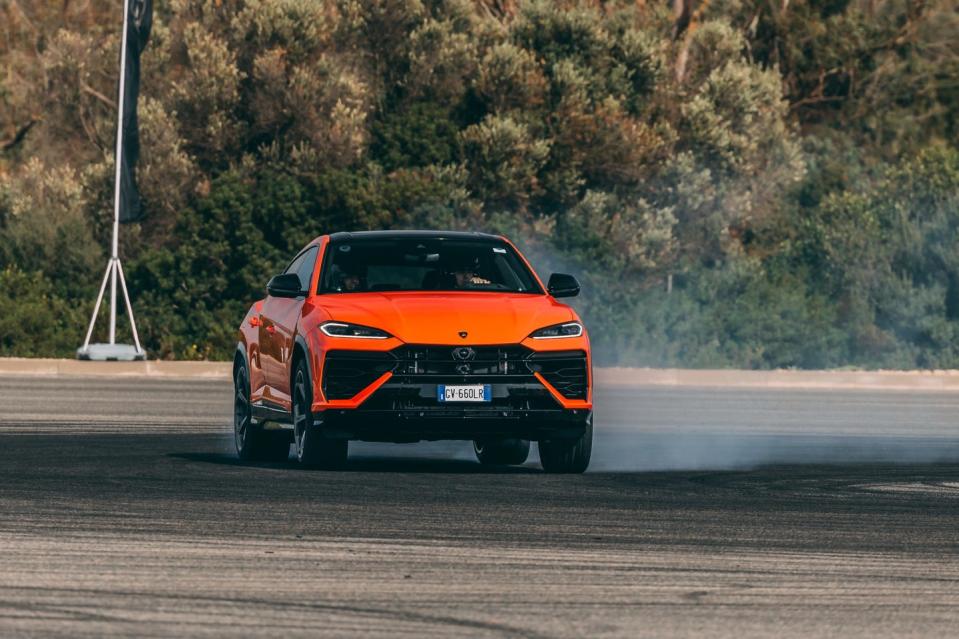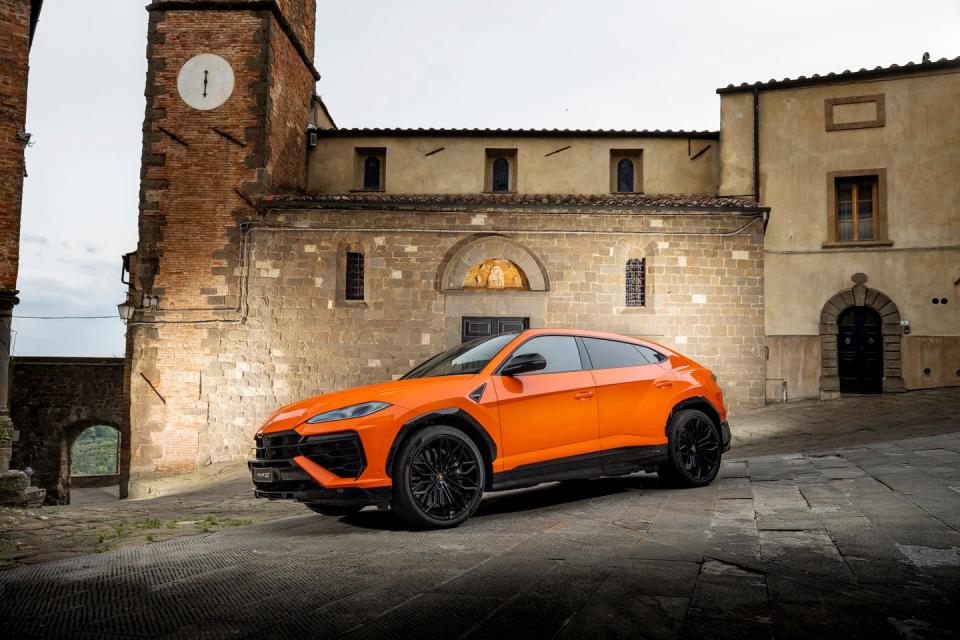Hybridized Lamborghini Urus SE Is a Tire-Smoking Monster

The south of Italy is not lawless, but it is law-lite. Proof comes as I'm driving the new Lamborghini Urus SE on a two-lane road in Puglia, the heel of Italy's boot. I'm in a line of traffic, all traveling at a decent clip over the posted 60-km/h speed limit, when the blind-spot monitor light illuminates. A glance in the door mirror produces the surprising sight of an ancient Opel Combo van making an ambitious passing move on the far side of a solid white line, lumbering past in a cloud of diesel particulates. That's 64 hp beating 789 hp, and I even have to lift off to create a gap to save the Opel from a Fiat Panda approaching at speed from the other direction.
So Italy remains Italy. Yet, despite its Lamborghini badge, the Urus's genetic heritage remains mostly German. The top of the Volkswagen Group is a very small place, and the SE uses the same plug-in-hybrid powerplant as the Porsche Cayenne Turbo S E-Hybrid; its twin-turbo V-8, electric motor, and battery pack are also the same as those in the Bentley Continental GT Speed Hybrid we reviewed last week. But while the hardware is shared, the Urus's dynamic character remains pure Lamborghini. Like its predecessor, this is the extroverted party animal of the luxury-SUV world.

The arrival of the Urus SE and the recent retirement of the Huracán mean Lamborghini's current and future model line will all be at least partially electrified. Yet despite the sizable 25.9-kWh battery pack it carries beneath the rear seat—enough to give an EV range of 37 miles on Europe's flattering test protocol—the hybridization has been done here mostly to deliver performance. Necessarily, it has also increased mass, with the SE's claimed 5520-pound curb weight representing a 670-pound bump.
Despite that, it can (briefly) play the eco-warrior. Like all European plug-in hybrids, the Urus defaults to its EV mode every time you start it. There is a definite novelty to traveling without the engine running, the SE projecting nothing more than a futuristic hum to warn other road users of its approach. As in the Porsche and the Bentley, the electric motor sits between the V8 and the eight-speed automatic gearbox and makes up to 189 hp and 356 lb-ft in its own right. Those figures aren't enough for serious acceleration in something so large, but in EV mode the Urus is still brisk enough to draw ahead of all but the most determined Italian traffic. Pressing the gas pedal harder fires the V-8 into raucous life, the accelerator lacking any resistance point to show where the electric motor is giving its all.

With the engine running, the SE becomes hugely fast. The familiar 4.0-liter V-8 makes 611 hp and 590 lb-ft on its own, slightly down from the Urus Performante that marked the pinnacle of the unhybridized version. But the contribution of the e-motor brings system peaks of nearly 800 hp accompanied by 700 lb-ft, with all that torque available across a Nebraska-wide plateau between 1750 rpm and 5750 rpm. It also dramatically sharpens reactions—certainly in the punchier Sport and Corsa modes. Where the old Urus suffered from discernible turbo lag low down, the SE responds with whipcrack speed to throttle inputs, a moving blue bar around the rendered rev counter showing the rate of electrical contribution.
On Lamborghini's numbers, the SE's 3.4-second 0-to-62-mph time is only a single tenth quicker than the outgoing Urus S, but the new car's 11.2-second 0-to-124-mph time is 1.3 seconds faster. Claimed top speed is now 194 mph—a number that seems shameful, impossible, and darkly exciting at the same time.

On road, experiencing the SE's full acceleration is necessarily limited by the need to pay at least nominal adherence to speed limits and the rate at which obstacles approach. My test car's V8 sounded great from inside the cabin, but Lamborghini still wanted to point out it had a European exhaust that is quieter than the U.S. market one. An American-spec version was brought to a parking lot to be revved up to prove the difference.
There is occasional confusion in the transition from pure electric to blended power, as in many plug-in hybrids. With the powertrain in its Hybrid setting there is a distinct pause between requesting full acceleration, the engine starting, the transmission working out which ratio to pick, and full fury arriving. Switching to either the Recharge or Performance mode keeps the engine running constantly and sharpens responses.
The Urus SE has a multitude of settings. Honestly, too many. In addition to the four powertrain modes there are six dynamic ones—cycled as before by a chunky lever on the center console. Three are intended for sealed surfaces—Strada, Sport, and Corsa in ascending levels of seriousness. Then there is also Sabbia (sand), Terra (earth), and Neve (snow) for off-road use; the Urus SE is definitely not a wilderness-grade SUV, but it does have a height-varying air suspension, an active center torque coupling, and an electronically lockable limited-slip differential at the rear. There is also a switch marked Ego, which brings up a smorgasbord of favored selections.
Lamborghini's engineers have done a fine job in distinguishing the different dynamic modes. In Strada the SUV is a gentle giant, softly sprung and pliantly damped, the V8 rumble slightly muted by a switchable exhaust valve, the transmission blending its changes with deft smoothness. Sport adds aggression, the suspension turning firmer and the 48-volt anti-roll system fighting lean much harder. The V8 sounds angrier, and the gearbox adds an entirely gratuitous torque bump to every open-throttle upshift (as it is a torque converter autobox, this is all for show.) Sport also slackens the stability-control intervention to the point of allowing the Urus to be pushed into power oversteer. Corsa—named for the track it seems unlikely many Urus SEs will ever meet—allows less slip as it is intended to minimize lap times.
Beyond the improved responses, the new Urus feels very similar to the old one on road. Which is why Lamborghini gave us the chance to also drive on Porsche's vast Nardò proving ground. Sadly, not on the infamous 3.8-mile handling track, but our time did include both a skidpad session and the chance to drive the Strada Bianca, basically a gravel rally stage. Both challenges were accomplished on what will be the standard-fitment Pirelli P Zero summer tires.
The new Urus's center differential uses an electronically controlled clutch pack to divert torque forward, giving much greater ability to vary the split between axles than the previous Torsen coupling, which always sent extra effort toward whichever end was slipping. According to Rouven Mohr, Lamborghini's chief technical officer, up to 80 percent of effort can now go to the rear, with the back axle's fast-acting limited-slip differential helping to find traction and control slides.
On the asphalt of the skidpad, the Urus proved happy to light up both rear tires and perform enormous, smoky drifts to order—the torque-nami also spinning the unloaded front wheel at the same time. One turning, three burning. While it is very hard to imagine owners making regular use of this ability, it did make for some dramatic pictures.

Although less spectacularly, the Urus impressed much more on dirt, remaining controllable and pointable even without any traction guardians, turning better, and finding more traction on the slippery surface than anything so big and heavy has any right to. Mohr says that much of the Urus's agility is down to the ability of the control algorithms for the various dynamic systems to predict what the driver is going to do next.
Despite the new powertrain, the Urus's design has changed little with what is effectively a gentle facelift. The hood has been reprofiled, the radiator grille is larger, and the headlights are narrower—but you really need both iterations side by side to see the differences. There are bigger changes at the rear, with the license plate mounting moving lower and the arrival of some unfortunate fake plastic mesh between the rear lights, these now featuring Revuelto-style Y-shaped elements. But the exhaust system is obviously genuine, with a substantial muffler visible under the bumper, the quad tailpipes sprouting from this.
The Urus is already the most successful vehicle in Lamborghini's history and a source of the profits that have enabled it to invest in more traditional supercars. Hybridization has added performance and improved drivability, enough to mostly offset the increase in weight in what was already a heavy car. Those who loved it before will love it still. Even disbelievers should have respect, if grudging, for a vehicle that delivers so well on its mission of cartoonish excess.
You Might Also Like

 Yahoo Autos
Yahoo Autos 